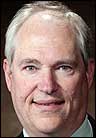Students at the University of Arkansas, and at neighboring high schools, are employing avant-garde technology to help the health-care industry learn just how RFID can make a difference in the operations of a company or organization. The researchers, under the direction of Craig Thompson, a professor of computer science and computer engineering at the university, hope the technology will provide a modeling and simulation environment that lets organizations test RFID implementations—down to such details as the number of RFID readers and tags, and where to put them—prior to physical deployment.
Thompson and the students have digitally created a hospital in Second Life, a three-dimensional virtual world developed and owned by Linden Lab in which millions of people visit to work and play online. The project is connected with the University of Arkansas’ Center for Innovation in Healthcare Logistics, in its College of Engineering, as well as with the RFID Research Center, part of the Information Technology Research Institute at the Sam M. Walton College of Business. The Center for Innovation in Healthcare Logistics, which opened in 2007, includes an interdisciplinary team of researchers who investigate supply chain networks and information and logistics systems within the broad spectrum of U.S. health care. Since 2005, the RFID Research Center has conducted studies regarding the use of radio frequency identification in retail.
Thompson has several years of experience working with databases, middleware and, most recently, RFID software. While attending SimU 2007—a conference on digital gaming, massive multiplayer online games and social networking, hosted last year by the University of Arkansas—he got the idea to explore virtual worlds and ubiquitous computing as a model for efficient operations. “It occurred to me that maybe we could build virtual RFID, so I challenged my students,” he explains. “In the real world, to try out RFID in a hospital, you often have to hire a contractor to come in with a design and estimates, then lay it out and test it, and perhaps it works or doesn’t work.”
But the virtual world would allow hospitals to model their environments in great detail, he says, depicting everything from rooms to beds and wheelchairs, as well as doctors and patients. “If you want to test where to put a tag on a box, and that box has bottles of water, you are probably better off testing in the real world,” Thompson says. “But if you want to test how many readers you might need in the nursery, and where you want them, you could use the virtual world. You could find out, ‘Do I really need complete coverage of this area, or just certain doors?’ You might be able to avoid the real-world pilot once you have really modeled the building well in the virtual world.”
On the University of Arkansas’ Second Life “island,” the students have created a virtual hospital containing operating suites, patient rooms, laboratories, a pharmacy, waiting rooms, stock rooms and bathrooms. (The group has posted a video demonstrating their virtual hospital.) The virtual facility also includes furnishings, such as working toilets, sinks, showers, chairs and beds, along with various diagnostic and medical equipment including electrocardiogram machines, respiratory rate monitors and portable X-ray machines.Avatars—representations of people (in this case, doctors, nurses, staff members and patients)—populate the site. The avatars and various assets are tagged with virtual RFID tags, each with its own unique number. There are also virtual RFID interrogators positioned in doorways and various other places throughout the hospital.
Using the tags and readers, the researchers have modeled a variety of business processes. For instance, one process simulates the delivery of equipment and goods to the hospital: A delivery truck drives up to a warehouse, where RFID-tagged items have been placed on a smart pallet (which has scanned the items’ RFID tags to create a bill of lading). The avatar loads the smart pallet onto the delivery truck, then drives to the hospital. Once the truck backs up to a dock, an RFID-enabled robot picks up the pallet, scans the items’ tags and transports the goods to the appropriate locations within the hospital.
Because these are virtual readers and tags, there are no missed tag reads, and read ranges are not constrained. “In Second Life,” Thompson states, “you know where everything is at any given time, because it is a simulated environment.” He adds, however, that detection probabilities—for example, tags will be read 95 percent of the time—can be inputted into the program, as can specific read ranges, to simulate a more realistic RFID implementation.
Ultimately, Thompson would like the project to move beyond modeling so the system can be utilized as a tool by real health-care organizations, including pharmacies and hospitals. Thompson and his team have devised a method for connecting an actual back-end database to Second Life via a programmable interface, and he says it is likely that any software system, such as a billing system, could be hooked up to the 3-D online world. Linking the virtual world with an actual system would enable hospitals to test a planned RFID deployment and determine how it works in the simulated world before actually going live with that system in the real world.
To further expand on this concept, Thompson and his students intend to work with the university’s RFID lab this semester. The lab includes a life-size model of an RFID-enabled store, which Thompson’s group plans to replicate in the virtual world, “creating a mirror image of this store,” he says. The lab store uses a real-time location system (RTLS) to detect when tagged items are moved, and Thompson and his team will connect this RTLS to the virtual store in Second Life. Whenever the actual RTLS registers an event, such as an item’s movement, that event will be depicted in the virtual world as well. “We’re going to tie real software to the virtual world,” he states.


